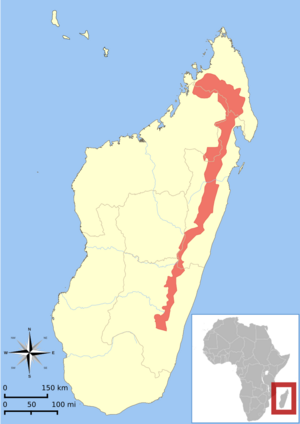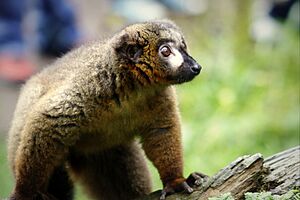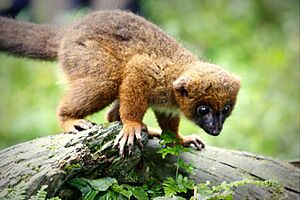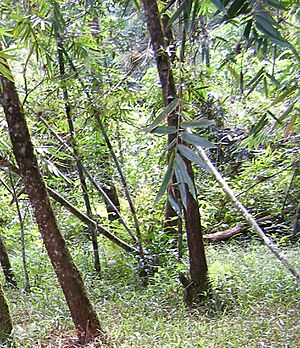Red-bellied lemur facts for kids
Quick facts for kids Red-bellied lemur |
|
|---|---|
 |
|
| Conservation status | |
| Scientific classification | |
 |
|
| Distribution of E. rubriventer | |
| Synonyms | |
|
The red-bellied lemur (Eulemur rubriventer) is a medium-sized lemur with a beautiful chestnut brown coat. These lemurs live only in the rainforests of eastern Madagascar. You can spot them by the white patches under their eyes. These patches look like "teardrops," especially on the males.
Scientists first identified this species in 1850. Red-bellied lemurs are active during the day and night. Males and females look quite different from each other. Since the 1980s, many studies have focused on these lemurs. Most of this research happens in Ranomafana National Park. The IUCN Red List calls the red-bellied lemur a vulnerable animal. This means they are at risk because their homes are being destroyed. People use slash-and-burn farming methods in Madagascar, which harms the lemurs' habitat.
Contents
What Do Red-Bellied Lemurs Look Like?
Male and female red-bellied lemurs have different appearances. This is called sexual dimorphism.
Male Lemurs
Males have thick, medium-long fur on their backs. This fur is a deep chestnut brown color. Their bellies are a lighter, reddish-brown. Their tails, noses, and heads are black. Males also have special scent glands on top of their heads.
Female Lemurs
Females have similar brown fur on their backs and tails, just like the males. However, their belly fur is a contrasting white-cream color. Their faces look similar to males. But their "teardrop" markings are not as strong. Females also do not have the thick cheek hairs that males do.
Size and Features
Unlike some other lemurs, the red-bellied lemur does not have ear tufts or a furry beard. Instead, they have thicker fur around their ears. This makes their faces look fuller.
Adult red-bellied lemurs are about 34 to 40 centimeters (13 to 16 inches) long. This measurement does not include their tail. Their tail is almost 20 percent longer than their body. So, a lemur's total length, including its tail, can be almost 1 meter (3 feet). A grown lemur usually weighs between 1.6 and 2.4 kilograms (3.5 to 5.3 pounds). Both male and female red-bellied lemurs can live for more than 20 years.
Where Do Red-Bellied Lemurs Live?

Red-bellied lemurs live in a narrow strip of eastern Madagascar's rainforest. You can find them as far north as the Tsaratanana Massif. There, they live at high elevations, up to 2,400 meters (7,900 feet). Their range extends south to the Manampatrana River. In the past, they lived even further south.
These lemurs are spread out and only live in healthy rainforests. You will not find them on the Masolala Peninsula.
Sharing Their Home
The red-bellied lemur shares its habitat with four other types of Eulemur species. In the far north, they live near the white-headed lemur. In the middle of their range, they are found with the common brown lemur. In the southern parts, they live alongside the red-fronted brown lemur and the gray-headed lemur.
It is easy to tell the red-bellied lemur apart from these relatives. The male's white eye "teardrops" are very unique. Also, the rich, dark fur of both sexes helps identify them. Interestingly, male red-bellied lemurs in the northern part of their range, like in Mantadia National Park, have a more distinct reddish belly. This is more noticeable than in males from the southern range, such as in Ranomafana National Park.
Their Forest Home
The forests where red-bellied lemurs live are dense and evergreen. The tops of the trees, called the canopy, are usually 25 to 35 meters (82 to 115 feet) high. These eastern lowland forests also have many different kinds of plants. This includes Pandanus plants, bamboo, and many types of orchids that grow on other plants.
How Do Red-Bellied Lemurs Behave?
Red-bellied lemurs live in small family groups. These groups usually have two to 10 individuals. They are one of the few lemurs that are cathemeral. This means they are active both during the day (diurnal) and at night (nocturnal).
Their home range is about 10 to 14 hectares (25 to 35 acres). You might find about five lemurs per acre in a typical area. The groups usually stay together as they move around their home range. They look for food from over 30 different plant species.
What Do They Eat?
Many people consider them frugivores, meaning they mainly eat fruit. But they also eat leaves, nectar, and flowers from many plants. Scientists believe these lemurs are very helpful in spreading seeds. They help new plants grow by carrying seeds to different places.
Reproduction and Young
A female red-bellied lemur usually has one baby per year. Sadly, about half of the baby lemurs do not survive their first year. Births usually happen in October and November. This is early summer in Madagascar.
For the first 33 to 37 days of their lives, baby lemurs cling to their mother or father. They switch between parents. After this time, the mother often stops carrying the baby. But the father might continue to carry the baby for another nine weeks.
Why Are Red-Bellied Lemurs Important?
Red-bellied lemurs have started eating new foods. One example is the "Chinese" guava, which actually comes from Brazil.
Some groups of red-bellied lemurs have become used to humans. This happens along certain trails in Ranomafana National Park. It also happens in some lower trail areas of Montadia National Park. If people are quiet and walk softly, the lemurs act tame. They might come down from the trees to within 2 to 3 meters (6 to 10 feet) of people. They will stare back with curiosity. They let people take pictures as they hold onto tree trunks. Sometimes, they even run on the ground for a bit.
Conservation Efforts
E. rubriventer lives in five national parks and seven special reserves in eastern Madagascar. However, they are still classified as vulnerable on the IUCN Red List. This is because their habitat is shrinking. People are still using slash-and-burn farming, doing illegal logging, and even hunting them. Scientists are studying this species in its natural home. They are also studied in places like the Duke Lemur Center.
See also
- Madagascar lowland forests
- Tropical moist broadleaf forest






